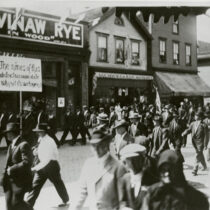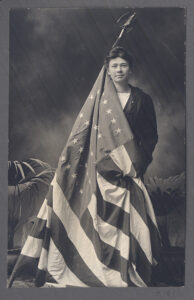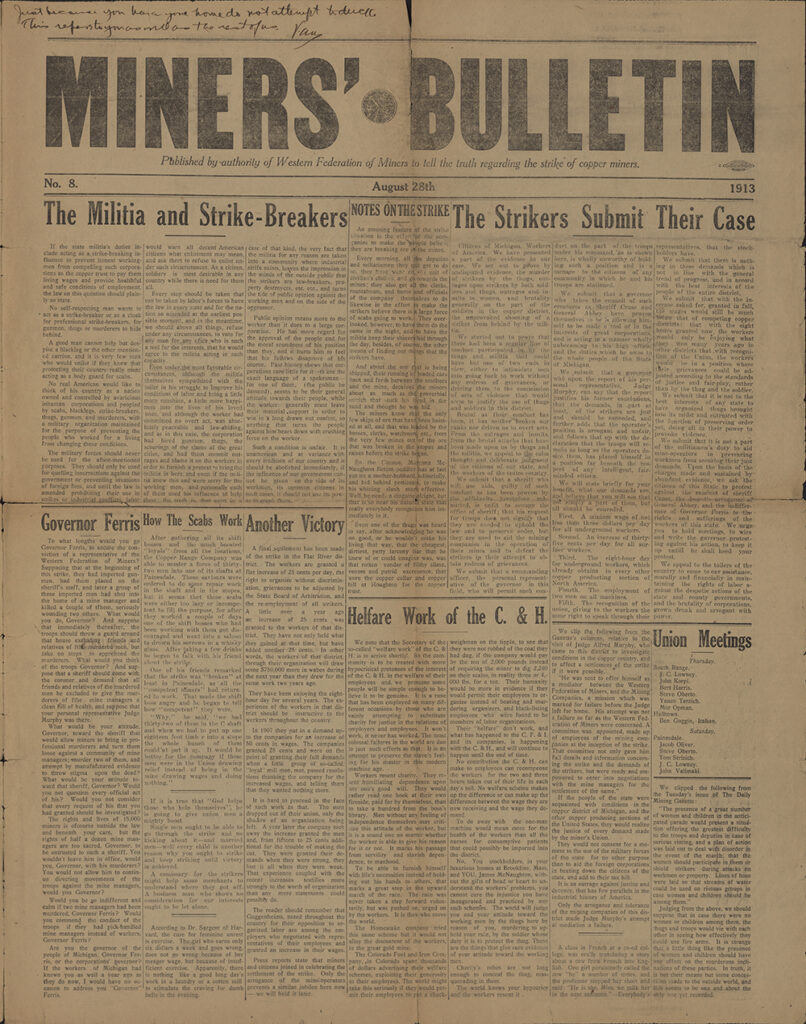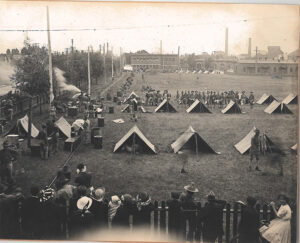Magazine

The Copper Line
After copper miners went on strike in Michigan’s Upper Peninsula in July 1913, violence wasn’t far behind. Newspapers, journals, and bulletins on both sides of the conflict flooded their pages with stories of harm, each blaming the other. Documents at the Bentley reveal multiple sides of a terrible conflict, and investigations at the highest levels of government to uncover what really happened.
by Lara Zielin
The accusations were scandalous. Women beaten and assaulted, children trampled by horses, homes raided, men thrown in jail without due process or shot point-blank in broad daylight.
The nation was horrified. Could these things possibly be true?
The 1913 labor strike in Michigan’s “Copper Country”—an area primarily comprising the Keweenaw Peninsula in Michigan’s Upper Peninsula—was led by copper miners against mining companies for the right to unionize, better working conditions and pay, and more.
The nine-month strike created a slew of hostilities and accusations on both sides. On one hand were claims that the miners were creating “riotous mobs” that were violent and needed to be severely reined in; on the other hand were claims that the armed guards brought in presumably to maintain the peace were harming women, children, and miners without cause.
“No time should be lost in instituting an exhaustive inquiry into the matter,” the Detroit Free Press admonished in August 1913.
Collections at the Bentley showcase multiple sides of this terrible conflict, as well as Congressional-level efforts to get to the bottom of what really occurred during nine months of unrest in Copper Country.
Striking Out
Before the strike, approximately 15,000 men worked Copper Country mines in 10–12 hour shifts in brutal and dangerous conditions. They were often first-generation immigrants from Croatia, Finland, Hungary, Poland, Italy, Slovenia, and more. As unskilled laborers, their employment options were limited. On average, one worker per week died in the mines.

“Big Annie” Clemenc poses in 1913 with the oversized American flag she often carried in stikers’ parades. Image courtesy of the National Park Service, Keweenaw National Historical Park
The strike was organized by the Western Federation of Miners (WFM), which initially recruited around 9,000 men to strike. At first, WFM placed no demands on the mining companies other than to ask for a meeting. While there were myriad issues to be raised—long hours, unsafe conditions, and low pay among them—their first letters simply asked all parties to convene. When the mining companies refused a conference, the strike began on July 23, 1913.
The strike shut down nearly all the mines in Copper Country. Miners took over the streets and paraded daily, often led by “Big Annie” Clemenc, a 6′ 2″ miner’s wife who regularly carried a 10-foot American flag.
James MacNaughton, manager of the Calumet and Hecla Mining Company, along with other mine managers, immediately met with Houghton County Sheriff James Cruse, asking him to request National Guard troops from Michigan Governor Woodbridge Ferris.
Ferris agreed and deployed the entire National Guard (more than 2,500 troops), while the mining companies tried to find replacement workers who would cross the picket line.
For weeks, the parades continued and the National Guard maintained relative peace. Because of this, Governor Ferris decided to reduce the number of National Guard troops in Copper Country. At the same time, the mine managers recruited men who were willing to cross the picket line. They also increased their own security through the Waddell-Mahon Detective Agency, a private firm of well-known strikebreakers. Local men were also deputized, more than tripling the local police force.
The increase in so-called “scab” mine workers, leading some mines to be re-opened, plus the increase in “private security”—all while the National Guard numbers dwindled—was a spark that lit a raging fire.
Months of Violence
On August 14, sheriff’s deputies and a group of strikebreakers arrived at a boardinghouse to arrest Croatian miners Ivan Kalan and Ivan Stimac. The two men had taken a well-known shortcut home and had been confronted with trespassing on land owned by the mining company. Kalan refused arrest and deputies opened fire, killing miners Alois Tijan and Steve Putrich.
On September 1, during a Labor Day parade through the town of Kearsarge, deputies began shooting at a group of mostly women and children. Fourteen-year-old Margaret Fazekas was shot in the head but miraculously lived after being taken to the hospital in Calumet.

The cover of the Miner’s Bulletin from August 28, 1913.
The Miner’s Bulletin from this time is filled with additional accounts of people who say they were attacked in various ways. Remarkably, every person’s account is notarized by the Houghton County Notary Public, and the notarization is printed with their testimony:
“[A] deputy sheriff came along and struck me a violent blow with his fist behind the left ear. I did not make any remarks but went quietly on my way.”—Palamidessi Gaetano
“I was frightened by one of the soldiers shooting. The two soldiers, one on each side, stopped me and pointed their bayonets at me, but inflicted no injuries, although it frightened me to a great extent.”—Elisabeth Szanyi
On the other hand are accounts in the archive asserting that either the miners’ stories were exaggerated, or that the injuries were all a result of lawful, uniformed men desperately trying to keep peace while a violent mob attacked.
The Committee of the Copper Country Commercial Club conducted a strike investigation and presented its findings to Governor Ferris in October 1913. “Every day riotous mobs roam through the streets of our communities and are held in check only by the force of the National Guard of the state,” their report stated. The strikers’ parades regularly caused a “a state of lawlessness, which absolutely baffled the civil authorities.”
And despite reports that uniformed men from the National Guard were harming civilians, the report maintained that “the conduct of both men and officers has been exemplary.”
In fact, it was the striking miners who were causing the greatest harm, according to the investigation. Train cars carrying replacement mine workers were regularly attacked and shot at. In December 1913, a few months after the investigation’s publication, three men slated to begin mining would be murdered, presumably targeted for being “scab workers.”
The investigation also asserted that the mining companies were doing “everything to make this industry as safe for its employees underground as possible,” and gave little credence to the miners’ demands for better pay or a standard eight-hour shift.
Christmas Disaster and a New Year Investigation
The miners’ strike conflict reached its pinnacle on Christmas Eve, 1913, when hundreds of people packed into the Italian Hall in Calumet to celebrate the holiday. Suddenly, someone yelled “fire!”
In the panic to escape, 73 people were crushed and trampled—59 of them children.

A military camp in Calumet in 1913, with the public observing.
There was no fire. Witnesses alleged that the person who cried “fire” was wearing a Citizens’ Alliance button, which represented the local organization opposing the WFM and the strikes.
Early in 1914, a subcommittee of the Committee on Mines and Mining in the U.S. House of Representatives arrived in Copper Country to investigate the strike. They took testimony from miners, members of the National Guard, newspaper reporters, even Margaret Fazekas, the young girl who was shot in the head and survived.
Throughout the hearings, the miners, strikers, and Copper Country community members were consistently asked about their immigration status, specifically whether they were U.S. citizens. “What is your nationality? Do you have papers? Are you American?”
Orrin Hilton, a lawyer for the miners, questioned Clarence Miller, a soldier, who thought that the striking miners weren’t “American” enough to carry the flag:
Hilton: What reason did you have for thinking that it was not a patriotic impulse that prompted them to carry the flag?
Miller: I have never seen very Americanized people in the parade.
Partial transcripts of the investigation are archived in the collection of Samuel Pepper, Chief Law Officer for the Michigan National Guard (MNG) and, later, Judge Advocate General of the MNG. The subcommittee later convened in Chicago to hear more testimony about the strike, though it didn’t lead to any substantive action or recourse.
The End of the Strike and Seeing Sides
Governor Ferris visited Copper Country in January 1914 and wrote to his children that the “Red” socialists of the WFM made his “blood boil,” but that the mine owners were “not angels” either. “There are as usual two sides to this dispute. Capital and labor should be twins. Should cooperate.”
Beth Kirschner, author of the novel The Copper Divide (Touch Point Press, 2021), researched several collections at the Bentley for her book and saw firsthand how multiple sides of the conflict reported events vastly differently.
The Mining Journal, for example, was almost exclusively anti-strike and anti-WFM, while Työmies (The Worker) was a radical socialist Finnish newspaper on the opposite side of the issue.
“The truth is sometimes multifaceted,” she says. “You can’t just take one side of the equation.”
Kirschner’s story follows Nelma, a wife of one of the miners who supports the strike, and her friend, Hannah, a merchant’s daughter who joins the Citizen’s Alliance in opposition of the strike.
“Because the stories were reported so differently, I tried to represent it through these different characters,” she says. “It’s a reminder to keep an open mind.”
After the Italian Hall disaster, many miners left the area. The WFM ran out of funds to support the strikers and, by April 1914, miners voted to end the strike. They were unsuccessful in achieving any of their demands.
The miners wouldn’t successfully unionize until 1939, but many mines were shut down by then. Laborers were already flocking to Detroit, where they had the opportunity to make $5 per day in comparatively better working conditions.
The last working Copper Country mine closed in 1995.
Sources for this story include:
Thelen, Greg: Copper Strike 1913–1914, Military History of the Upper Great Lakes, October 2015. Strike Investigation by the Committee of the Copper Country Commercial Club of Michigan, 1913. Miners’ Bulletin, Western Federation of Miners: August 13, August 28, 1913; April 14, 1914. The Girl Who Lived, Michigan Tech Archives blog. Conditions in the Copper Mines of Michigan: Hearings Before a Subcommittee of the Committee on Mines and Mining, House of Representatives, Sixty-Third Congress, Volumes 1-7. Woodbridge N. Ferris papers. Roy C. Vandercook papers. Samuel D. Pepper papers.
